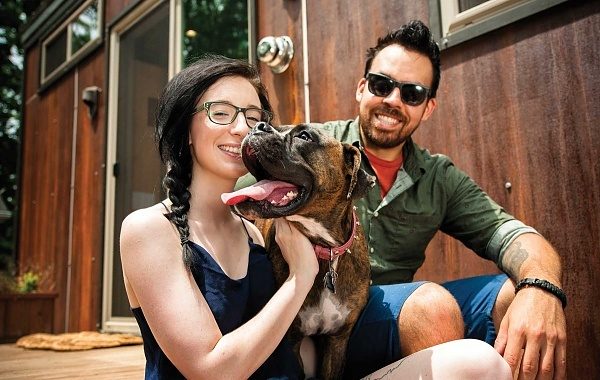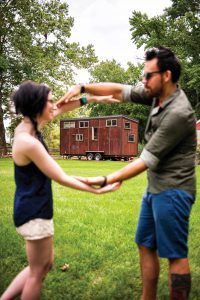
Vince Sorgentino and his girlfriend Sam Adams love their tiny home in Mullica Hill — all 264 square feet of it
Vince Sorgentino knows bigger isn’t always better. The 29-year-old lives with his girlfriend, Sam Adams, just outside Mullica Hill in a home with a total living space of just over 250 square feet.
When construction on their tiny home, built on a movable trailer foundation, was completed in 2014, the couple joined a trend that has been spreading across the country for several years. Today in the United States, there are a few thousand tiny homes, the largest of which top out around 300 square feet. Netflix documentaries, Pinterest boards and television shows like “Tiny House Nation” have exposed huge numbers of people to the benefits of living small and have hugely increased the popularity of these mini domiciles. Sorgentino saw his first tiny home in 2010.
“I was still in optometry school, racking up $200,000 in debt,” he says. “I liked the freedom that came with living that small. I’m kind of a hippie at heart. When I met Sam in 2013, she was finishing up grad school and headed to medical school. We moved to Bala Cynwyd, and I hated it there. It was close to her school, but we were wasting like $1,800 a month on rent. So we just thought, ‘Let’s do it.’ We couldn’t buy a regular house, because we’re going to move in four years when she finishes school, but why couldn’t we make this work?”
After some online research on companies that sell completed tiny homes, customizable shells and blueprints for DIY versions, Sorgentino and Adams, 26, reached out to “Tiny House Nation.” The show ended up working with the North Carolina-based builders at Wishbone Tiny Homes to create Vince and Sam’s totally customized home.
“My big thing was wanting to be as big a part of the build as possible,” Sorgentino says. “I drew floor plans out like two years ago. I knew what we needed in order for the house to work for us. I don’t regret doing the show – I’d do it again – but if I could do it over I think I’d try to be even more hands-on. They exceeded my expectations with some things and came up way short on others. Some of the craftsmanship was done as quickly as possible to get it done. When the camera crews left, it was definitely TV-ready, but not necessarily live-in ready.”
One aspect of the home that really fits the couple’s super-active lifestyle is the built-in workout equipment, like monkey rings and a rock-climbing wall.
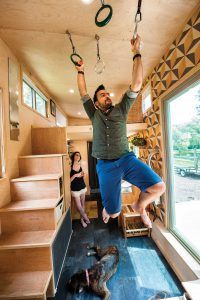
Monkey rings and a rock wall act as home gym equipment
“We like to work out. We work hard and play hard,” Sorgentino says. “I’m a huge fan of the monkey rings; I use them every day. For me, it feels like a little playground. It’s fun to be here. I also really like our library/den area. There’s a lot of storage throughout the house, and that’s worked out really well.”
The layout of the home includes two lofts. One is the couple’s master bedroom, and the other doubles as Adams’ home office and a guest bedroom.
“The size of the lofts has been really great and surprising,” Sorgentino says. “Not everyone can live in a space this small. I know I couldn’t do it with anyone else. You have to be open and totally willing to communicate with each other – living like this forces you to do that. If there’s a problem, you have to address it immediately. Even before we lived like this, Sam and our dog were like magnets – always on top of me – so I’m used to it. But if she wants to get away, she can go upstairs to her loft and be in her own space.”
Living small has required some adjustments. Sorgentino and Adams have had to get accustomed to the utilities a small space requires. They’ve also had to significantly reduce their possessions to make the tiny home work.
“We have a composting toilet, which some people think is weird, but I really don’t mind. It’s as much an art as it is a science, and it’s really not as gross as it sounds,” Sorgentino says.
“Once you figure out what works for you, it’s not bad. Our heating system is awesome. I didn’t compromise on the Dickinson Marine stove (a propane heater designed for a boat), and our house was warm all the way through the miserable winter we had. One of the biggest problems was our hot water heater. The lines froze on it twice, and for three weeks we didn’t have hot water. For an eye doctor, I’ve gotten pretty good at plumbing. When it first busted it took me three and a half hours to replace the water heater, and the second time it took me less than 15 minutes.”
Sorgentino says the most difficult aspect of moving into a tiny house is finding a good location for it. Most municipal building and zoning laws have a minimum square footage requirement, so it can be difficult to find a town where a tiny home is legal.
“The biggest problem is where to put it,” says Erika Dani, state chapter leader for the American Tiny House Association. “People call and email me all the time and tell me they’re interested in having a tiny house, but they don’t know whether their municipality will allow it. It’s hard to answer, because it varies from town to town. That’s part of the reason people started putting them on wheels – once it’s technically a vehicle, it falls under the Department of Motor Vehicles.”
Dani says she first became interested in tiny homes about five years ago, just as they began gaining popularity in the Midwest.
“My dad lives in a 168-square-foot camper trailer year-round,” she says. “I got to learn about living in small spaces via living with him. Then I saw a photo of a tiny house online, and they’re just so cute. I joined tiny house meet-up groups in Minnesota, where I was living at the time. When I came out to New Jersey for graduate school, I started to do more research on tiny houses from an academic standpoint.”
Through her research, Dani found that people move into tiny homes for a variety of reasons, but generally older people are hoping to find fulfillment with fewer possessions, and young people are hoping to save money.
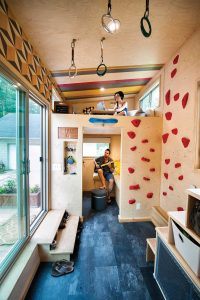
A loft doubles as a home office and guest bedroom
“For some people, they lived in their large McMansion and realized they don’t need so much space or stuff,” Dani says. “For others, they’ve never owned a home and this is an easier way. The appeal is a debt-free, mortgage-free house. Some people do it because they want to live green or off the grid in the middle of nowhere.”
Dani attributes the recent surge in tiny homes’ popularity to the online and brick-and-mortar companies that have sprung up, turning a trend into a thriving industry.
“In the beginning it was more like a few people doing these one-off tiny houses,” she says. “But it’s become an industry now, with a huge variety of things on the market. There are an increased number of companies dedicated to selling tiny houses and items designed for those houses. There are trainings you can take on how to minimize your belongings or effectively store things.
And beyond that, we’re seeing people who are interested in tiny homes getting organized. They’re becoming a force on Facebook and forming meet-up groups all over the country.”
Legislators in New Jersey see the tiny home movement as a potential solution to the state’s issues of homelessness and impoverished living conditions. In late 2014, Sen. Raymond Lesniak (D-Union) introduced legislation that would relax state building codes and give municipalities the ability to participate in a Tiny Home Pilot Program. State grants would allow tiny homes to be utilized as affordable housing units.
While that original bill did not pass, Dani says the idea of using small-scale housing to combat homelessness isn’t going anywhere. She thinks that if a pilot program were established, municipalities would be eager to volunteer.
“I think most urban planners and city officials are not against tiny houses,” she says. “It’s just a matter of figuring out how you fit them into your city. Where do you put them? What effect do they have on property values? A lot of these things are untested, but as we move forward I think we’ll come up with solutions.”
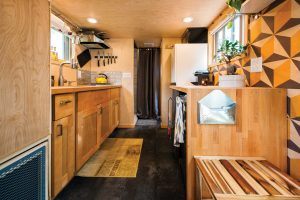
Clever design elements fill the house, like a magnetic bar to store knives in the kitchen
Sorgentino says that while there is a financial benefit to living small, what he and Adams are really after is a sense of simplicity.
“The financial freedom is an added perk, but it’s not a good enough reason to do this,” he says. “It really came down to us wanting to live a simpler lifestyle. There have been a lot of uphill battles, because society doesn’t really accept this yet. The American marker for success is how much house you have, but I could care less.
I hear stories about people who have these massive mortgages, and they’re just chasing a dollar, working their lives away. They say 30 to 40 percent of your income goes toward housing – why does it have to be that way? It’s anxiety-inducing. I don’t need 3,000 square feet to be happy. Happiness comes from within, and home is what you make it.”

